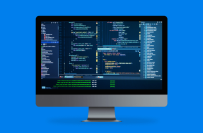与 Ava 聊天 - 您的人工智能业务顾问
大家好,我是 Ava,您的 AI 指南,可帮助您增强业务!
无论您已经在经营一家企业还是梦想创办一家企业,我们都会用AI赋能威客帮助您将愿景变为现实。分享您的业务目标,我们将共同创建一个项目,供我们才华横溢的威客竞标。让我们让您的愿景成为现实!
我已经有一份事业
我要创业
将对话发送到您的电子邮件时出现问题。请稍后再试。
您每小时只能保存一次对话。请稍后再试。
你们的谈话太短了。继续与 Ava 聊天以启用保存功能。
Software Architecture
This article will tell you all you need to know about software architecture and what to look for in a software architect.
2022年4月20日 • 阅读需12分钟
由Lee J.于2023年3月6日进行更新

复制到剪切板失败,请修改权限后重试。
复制到剪贴板。

Fact | Description |
|---|---|
Fact | Description |
Fact | Description |
Fact | Description |
Fact | Description |
Fact | Description |
Software architects make high-level decisions that lay the foundations for the success of your software engineering project. Their input is crucial in assuring that you select the right architecture while the project is in its infancy and changes can still be made.
Source: iStock
This article will tell you all you need to know about:
What a software architect is
Why they are crucial to your success
The risks of software development without one
The most common types of software architecture patterns and their uses
What to look for in a software architect
How much it costs to hire a software architect
How to hire a top-quality freelance software architect
So, let's get into the details.
What is software architecture?
Software architecture is the basis for all good software engineering and development. It is the organization of the individual subsystems required to create a software program, and the roles and responsibilities assigned to each piece of code to determine the way in which they interact and communicate with one another.
A software architect is responsible for laying the groundwork for the implementation of a successful software infrastructure.
It is important to distinguish software architecture from software engineering and software design. While there is some inevitable crossover between them, they are separate entities. Software architecture is the first real application of technology in turning an idea into a functioning app or program.
Failure to determine the most appropriate software architecture has been the ruination of many software development projects over the years. Making the wrong choice, or in some cases commencing a project without a software architecture pattern in place, inevitably leads to the creation of codes that have a vague purpose and no clear responsibilities. This results in poor communication between the various aspects of the system which in turn leads to a poor user experience.
When you hire a software architect be sure to thoroughly check them out and make sure they have the necessary skills and experience.
Why is software architecture so important?
To understand the importance of software architecture, imagine you have decided to build your own home. You would know what you want from it in terms of functionality, security, relationships between various parts of the building and capacity to extend. The best person to draw up the plans would be an architect.
Software architecture works in much the same way. As a business owner or entrepreneur, you will know better than anyone what your users want from your website or app. But that is very different from knowing how to deliver it.
Choosing the right software architecture is the earliest point in the software development process that the design decisions which govern its system can be fully analyzed. This is a pivotal moment in the software development lifecycle and requires an expert. Up to this point, the idea itself and your vision for how your new software program or app might work has probably been the most important factor. The choice made at this point in the process will decide if and how the dream will be realized. It is generally accepted that once an architecture has been chosen, there is no going back and no amending it.
Software architects are like project managers for software engineering and development. Their role is to understand your vision and create a blueprint for a system that will deliver it as quickly as possible while ensuring it performs well and can be adapted to meet changing needs. Using software design tools, they will build software architecture to support your requirements and that reduces the chances of bugs or security issues that will affect performance and CX.
Bugs and flaws are a risk at every stage of architectural design and software development. A good quality software architect will analyze the fundamental design of software, assess any risks to security or performance, identify all potential weak points, and build in layers of protection to prevent them from becoming problematic.
Software architecture decisions also determine the basic characteristics of the system. Some are inherently scalable while others are more rigid. It is expected that throughout the software development life cycle, there will be various iterations of the system, but only with knowledge and forethought can you assess the potential strengths, threats and weaknesses of a wide range of software architect solutions can one choose the best for each project.
Well-constructed software architecture will:
Expose the systems structure while keeping its implementation details hidden
Realize every possible use case
Integrate all stakeholder requirements
Handle quality and functioning requirements
Improve user experience (UX)
Improve CX
The success or failure of a software system is heavily influenced by the choice of software architecture. Choose poorly and the system is doomed to fail at some point in the software development cycle so hiring a software architect is one of the most important decisions you will make.
What are the risks of getting software architecture wrong?
Companies create software programs to engage and convert their audience so the primary function of any software design is that it should help generate increased ROI. That will only happen if the end users – your target market – see value in it. Sometimes the value is in enjoyment of using an app, at other times it will be in being able to place an order quickly and easily. In either event, their experience of using your app or website is a key factor in determining their level of CX and opinion of your brand.
Striking the right balance between the business needs and the technical requirements is crucial. Software architecture bridges the gap between the two.
Software development can be split into various stages and in many cases, different team members will have specialisms which mean they are only involved in one aspect of the complete engineering project. This method of working is required due to the complex nature of the development process, but it brings risks. Without a software architect to oversee the project from start to finish, each individual team member is at risk of being asked to carry out their part of the process without an understanding of the overall direction and strategy of the project.
Even if you use only the best software engineers and developers, if you don’t hire a software architect you run the risk that the disparate parts of the program will not connect and communicate in the most efficient manner. This will result in poor CX, high customer turnover, low conversions and reduced ROI.
What are the different types of software architecture?
There are various types of software architecture patterns, each of which has been tried and tested to ensure it solves a particular problem. Each pattern has its own organizational structure for its components.
The most commonly used types of software architecture patterns are:
1. Layered Pattern
The most common software architecture pattern which is widely used for E-commerce. Components are separated into four layers of subtasks which are arranged on top of each other.
Each layer performs a specific set of tasks and is independent of every other layer. This allows for modifications to be made to an individual layer without affecting the other three layers.
The four layers are:
Presentation layer (The user interface layer)
Business layer (For executing actions as per the users’ request)
Application layer (The medium for communication between the ‘presentation layer’ and ‘data layer’
Data layer (For managing data)
2. Client-Server Pattern
This pattern includes a server and multiple users. It is often used to create banking apps, file sharing apps and email systems.
The server contains resources such as data, files and access to services and each resource can be requested by a user. The server responds with a simple, pre-determined action in accordance with the request.
The client-server pattern has two major entities. They are a server and multiple clients.
3. Event-Driven Pattern
An event driven pattern requires three components:
An event source (e.g., ‘Submit’ button)
An event object (the ‘object’ created by the event source)
An event listener (the part of the program that identifies the appropriate way for the app or site to respond to the source)
Event-driven patterns are common when building websites but can also be used for E-commerce.
4. Microkernel Pattern
A microkernel pattern is created using two predominant components - core system and plug-in modules.
The core system is designed to handle the basic operations, while the plug-in modules take care of additional features.
This is very common in mobile app development as it’s important to be able to update and amend the app regularly to keep users engaged.
The plug-in modules handle the extended functionalities (like extra features) and customized processing.
5. Microservices Pattern
A kind of hybrid of the benefits attributed to microkernel patterns and layered patterns. Instead of one large application, a microservices pattern is made up of many small services that together form an app. Each microservice is independent from the rest so they can be amended, added or deleted in isolation without affecting other microservices.
This is a popular choice for apps that need to be scalable, flexible and resilient.
These are just a selection of some of the most popular software architecture patterns. Each has strengths and weaknesses which you need to bear in mind when selecting the right one for a given software development project. Choosing the right architecture pattern at the outset of the project relies on two major factors:
Understanding the underlying purpose of the software development
Extensive knowledge of software architecture patterns
While a quick internet search will throw up plenty of websites that say they can guide you through creating your own software architecture, without deep knowledge of the various types of patterns and the results they are likely to yield, you run the risk of developing substandard architecture that will eventually see its weaknesses exposed or investing time and money in a development project that subsequently must be scrapped.
In either case, going it alone can be a costly error that leaves you regretting your decision. If you are not an expert, your time will be better spent identifying and hiring a freelance software architect that understands your vision and can provide the guidance you need.
What to look for in a software architect
The role of a software architect is varied and requires multiple skills:
Design expertise – When hiring a software architect, you should look for someone with a proven track record of delivering successful software design using a diverse range of methods and approaches. You may not be an expert, but with a general idea of the main types of software architecture you can probe a little bit into their use and implementation of different techniques.
Design reviews – They will need in-depth knowledge of designs so enable them to quickly and accurately decide which plans to proceed with and which to reject at the design stage.
Deep knowledge of multiple programming languages e.g., Java, JavaScript, Python, Ruby, Rust etc
Domain expertise – Expert knowledge of the system to be developed and the plans for software evolution are vital to selecting the right software architecture for the project.
Leadership skills – A software architect will often take a back seat when it comes to hands-on development, but they will see the project through from concept to reality and ensure the team stays focused on the task. They will need to supervise individual designers and developers, provide progress reports to stakeholders, manage the project budget and oversee quality assurance.
Communication – Seamless communication is essential for efficiency. If you decide to work with a remote software architect, be sure to agree on communication protocols early on taking different time zones into consideration.
Source: Unsplash
How much does a software architect cost?
The costs of a software architect vary according to several factors including:
Complexity of the project
Experience
Location
Whether they are employed or freelance
Naturally, the more complex the project the more you will be reliant on experience when seeking a software architect. However, be wary when defining what ‘experience’ really is. Years of experience in software design do not necessarily equate to an experienced software architect. Be sure to talk through their experience with projects similar to yours when deciding who to take on.
For more simple projects, you may not need to employ the services of somebody with many years’ experience. In this instance, you may want to opt for somebody who is less experienced and reflects this in their fee.
Software architects are in high demand globally as companies continue to take advantage of the digital transformation and the increasing popularity of the Internet of Things (IoT). Subsequently, hiring freelance software architects is becoming the first choice for many technical leaders.
We’re all used to remote working and video calls these days, so location is not the barrier it once was. You can work with top talent from around the world no matter where you are based – and you can make big savings by doing so. For example, to hire a freelance software architect in Silicon Valley you can expect to pay around $70 per hour. Hire someone from Eastern Europe and that drops to around $56 per hour – a 20% saving.
After years of government investment by many Eastern European governments, there is now a plethora of tech professionals offering to work on software projects remotely.
The decision on whether to hire a freelance software architect or employ one full time is largely dependent on your budget and how much work you have for them. Increasingly, firms are moving away from in-house software development due to the costs associated with recruitment, training and employment.
Source: Unsplash
Technology is a fast-moving industry and business leaders are choosing to keep their operations agile and flexible. As new systems emerge, new talent emerges too. With access to the top tech talent from all corners of the globe at your fingertips, why limit all your tech projects to one small group of people who live within commuting distance of your office?
As tech solutions become increasingly complex, the need for the right software architect becomes ever greater. Hiring freelance software architects and software engineers significantly widens the talent pool you have access to. You can pick the right team for each software development project according to its specific needs and available budget.
Your best bet is to hire a freelance software architect. This way you can discuss the specific requirements of the project and make sure the person you select to play a pivotal role in driving your business forward matches your criteria.
How to hire a top-quality software architect on Freelancer.com
There are two main ways to hire a software architect on Freelancer.com.
Hire a freelancer directly
Post a project
Hiring a freelancer directly requires you to go through profiles to identify suitable candidates and then contact them with a proposal for your project.
When you post a project, interested freelancers will contact you and provide a quote for completing the project.
In either event, a clear brief is essential. That doesn’t mean you need in-depth knowledge of software architecture, but you need to be clear in your own mind what you want from the end product. You will need to consider its immediate and future functionality as both will be important information to pass on to your software architect.
Your brief should be just that – brief – but comprehensive.
You’ll also need to set a budget. Remember, this is an investment in your business so don’t just think in simple cost terms – think ROI. The cheapest option could end up costing you more in the long run if it doesn’t appeal to users or needs to be replaced because it can’t cope with the volume of visitors.
Your budget must be affordable but realistic to attract interest from the top talent.
If you have posted a project, the first time you get to review profiles will be after a freelancer has placed a bid. When reviewing bids and profiles pay attention to:
Bid amount
Written response (Is it specific to your brief? Does it answer any questions you asked? Does it give you confidence in them?)
Star rating
What previous clients are saying about their skills and professionalism
Evidence of working on a diverse range of projects
Portfolio
Project completion rate
On-time rate
On-budget rate
You should also look out for:
The Preferred Freelancer badge. The orange badge with a white star that indicates they have achieved a high rating and good reviews - and have been accepted into the elite Preferred Freelancer Program.
The Verified badge. The blue shield with the white tick that shows Freelancer.com has verified the freelancer’s identity.
A software architect is an integral part of any software development project. Their role is to turn your vision into reality. You need someone with a high level of ability, good communication and strong leadership skills.
Find a freelance software architect with the knowledge and experience to help take your business to the next level now.
与我们的Technical Co-Pilots进行沟通来获得项目帮助
专为您推荐的文章

Want to get into web development but don't know whether to be a front end or back end dev? We'll teach all of the skills required for both jobs.
8 min read

Learn the complete end-to-end process of building a successful website for your business in our comprehensive guide
19 min read

You can hire a programmer to solve just about any complex problem, the problem is knowing how to hire the right professional for the job. Learn how..
13 min read

Great graphic design will solidify your brand identity and drive revenue. Find out how to hire a great designer and what you should expect to pay.
9 min read
谢谢!我们已通过电子邮件向您发送了索取免费积分的链接。
发送电子邮件时出现问题。请再试一次。
加载预览
授予地理位置权限。
您的登录会话已过期而且您已经登出,请再次登录。






















